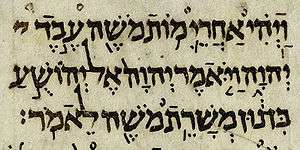Ktav Ashuri
Ktav Ashuri (Hebrew: כְּתָב אַשּׁוּרִי, ktav ashurí "Assyrian script"; also Ashurit) is the modern-day Hebrew language name given for the Modern Hebrew alphabet now in use by the nation of Israel, used by them to write both the Hebrew language and Aramaic.

In Jewish halachic law, tefillin (phylacteries) and mezuzot (door-post scripts) can only be written in Ashurit.[1]
History
Ktav Ashuri is the classical Hebrew name as used in the Talmud; the modern Hebrew term for the Hebrew alphabet is simply אלפבית עברי ("Hebrew alphabet"). Consequently, the term Ktav Ashuri refers primarily to a traditional calligraphic form of the alphabet used in writing the Torah.[1]
The name reflects the fact that the Hebrew alphabet is was derived from the Aramaic alphabet (modern Hebrew אלפבית ארמי), it thus refers to "the Aramaic alphabet as used in Judaism",[2][3] and is sometimes referred to as the "Assyrian script."
The name contrasts with the name Libonaa (or Liboni) given to the Samaritan alphabet, and by extension the Paleo-Hebrew alphabet. This name is most likely derived from Lubban, i.e. the script is called "Libanian" (of Lebanon), although it has also been suggested that the name is a corrupted form of "Neapolitan", i.e. of Nablus.[4]

According to the Talmud, Ezra was the first to enact that the sefer Torah be written in the Assyrian alphabet rather than in the Paleo-Hebrew script used formerly and permitted that the Book of Daniel be composed in Aramaic.[5] The term "Ashurit" is often used in the Babylonian Talmud to refer to the modern-Hebrew writing script.[6]
According to the Babylonian Talmud, the Torah was given by Moses in the Assyrian alphabet, later changed to the Paleo-Hebrew script, and, again, the Ashurit script during the time of Ezra.[7] The matter, however, remains disputed, some Sages holding the view that the Torah was originally inscribed in the Old Hebrew (Paleo-Hebrew) script.[8]
Mention of the Ashuri script first appears in rabbinic writings of the Mishnaic and Talmudic periods, referring to the formal script used in certain Jewish ceremonial items, such as sifrei Torah, tefillin, mezuzot and the Five Megillot.[9] Also sometimes called the "square" script, the term is used to distinguish the Ashuri script from the Paleo-Hebrew alphabet.
The Talmud gives two opinions for why the script is called "Ashuri": either because the Jews brought it back with them when they returned from exile in Assyria;[10] or alternatively, this script was given at Sinai and then forgotten and eventually revived, and received its name because it is "meusheret" (beautiful/praiseworthy or authorized).[11]

See also
Notes
- Danby, H., ed. (1964), "Tractate Megillah 1:8", Mishnah, London: Oxford University Press, OCLC 977686730, s.v. Megillah 1:8, p. 202 (note 20); Yadayim 4:5-6, (note 6)
- Steiner, R.C. (1993). "Why the Aramaic Script Was Called "Assyrian" in Hebrew, Greek, and Demotic". Orientalia. 62 (2): 80. JSTOR 43076090.
- Cook, Stanley A. (1915). "The Significance of the Elephantine Papyri for the History of Hebrew Religion". The American Journal of Theology. University of Chicago Press. 19 (3): 348. JSTOR 3155577.
- James A. Montgomery, The Samaritans, the earliest Jewish sect (1907), p. 283.
- Jerusalem Talmud (Megillah 10a); Babylonian Talmud (Sanhedrin 21b [end]); cf. Tractate Soferim 1:6
- Megillah 17a, Megillah 18a
- Babylonian Talmud (Megillah 2b; Shabbat 104a; Zevahim 62a; Sanhedrin 22a)
- Jerusalem Talmud (Megillah 10a)
- Rich, Tracey R. "Judaism 101: Hebrew Alphabet". www.jewfaq.org. Retrieved 21 February 2017.
- Sanhedrin 22a
- Sanhedrin 22a